Choosing a dog breed that fits seamlessly into a bustling family schedule can feel overwhelming. After all, pet ownership demands time, attention, and care—resources that busy families might find scarce. That’s where low maintenance dog breeds come into play, offering the perfect balance between companionship and practicality. Whether you live in a cozy apartment or a spacious house, want a pup that requires minimal grooming, or need a friendly canine match for children and seniors alike, understanding the nuances of low maintenance breeds can set you up for success.
In this detailed guide, I’ll walk you through exactly what “low maintenance” means when it comes to dogs, key factors to consider before adopting, profiles of the best breeds suited for busy families, and essential tips on grooming, training, and wellness. By integrating insights backed by canine experts, real-life owner experiences, and scientific understanding, this article is your go-to resource for finding and caring for one of the best low maintenance dog breeds for busy families. So, let’s dive right in and make your journey toward a happy, healthy dog ownership experience as smooth as possible!
Understanding Low Maintenance Dog Breeds: What Does It Really Mean?
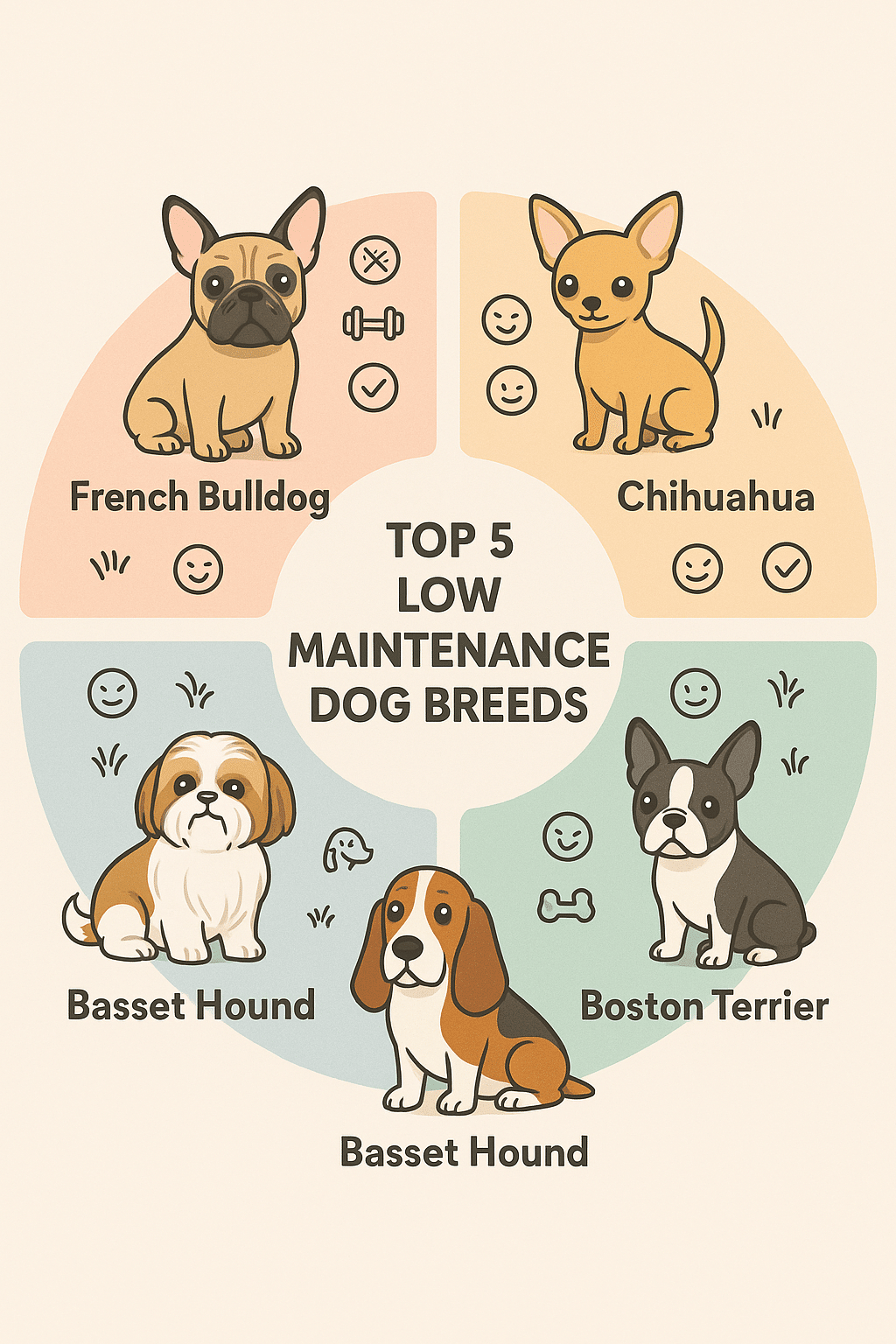
When we say a dog is low maintenance, it’s more than just saying, “It’s easy to take care of.” Low maintenance dogs have specific qualities that require less ongoing effort concerning grooming, exercise, health upkeep, and temperament management. Let’s break down these elements clearly.
Defining Low Maintenance in Terms of Grooming, Exercise, and Temperament
First off, grooming: Some breeds practically groom themselves with minimal brushing or bathing. For example, short-haired breeds don’t mat as easily, and breeds with tight coats often need fewer baths. Low maintenance dogs often have manageable coat types that shed minimally or have naturally oily fur that repels dirt.
Next, exercise: A low-maintenance dog is one with moderate to low physical activity needs. They’re content with daily walks or indoor play sessions instead of hours of running and fetching — a big plus for busy families who can’t dedicate a chunk of the day to their pet’s exercise.
Temperament also plays a huge role. Low maintenance breeds often have calm, adaptable, and patient temperaments. They aren’t prone to extreme separation anxiety, destructive behaviors, or excessive barking that can complicate life for active households.
The Role of Shedding Levels and Allergens in Maintenance
Shedding and allergen levels are vital considerations, especially for families with allergy sufferers. Low maintenance dog breeds often fall into hypoallergenic or low-shedding categories. While no dog is 100% hypoallergenic, breeds that shed less release fewer dander particles — primary allergy triggers. A dog with low shedding keeps your home cleaner, reduces allergy flare-ups, and lessens grooming frequency.
Many breeds considered low maintenance blend low grooming needs with low shedding coats—for example, the Basenji or the Bichon Frise. These breeds help families enjoy the pet companionship experience without the high upkeep typically associated with furry friends.
Key Factors to Consider When Choosing a Low Maintenance Dog Breed
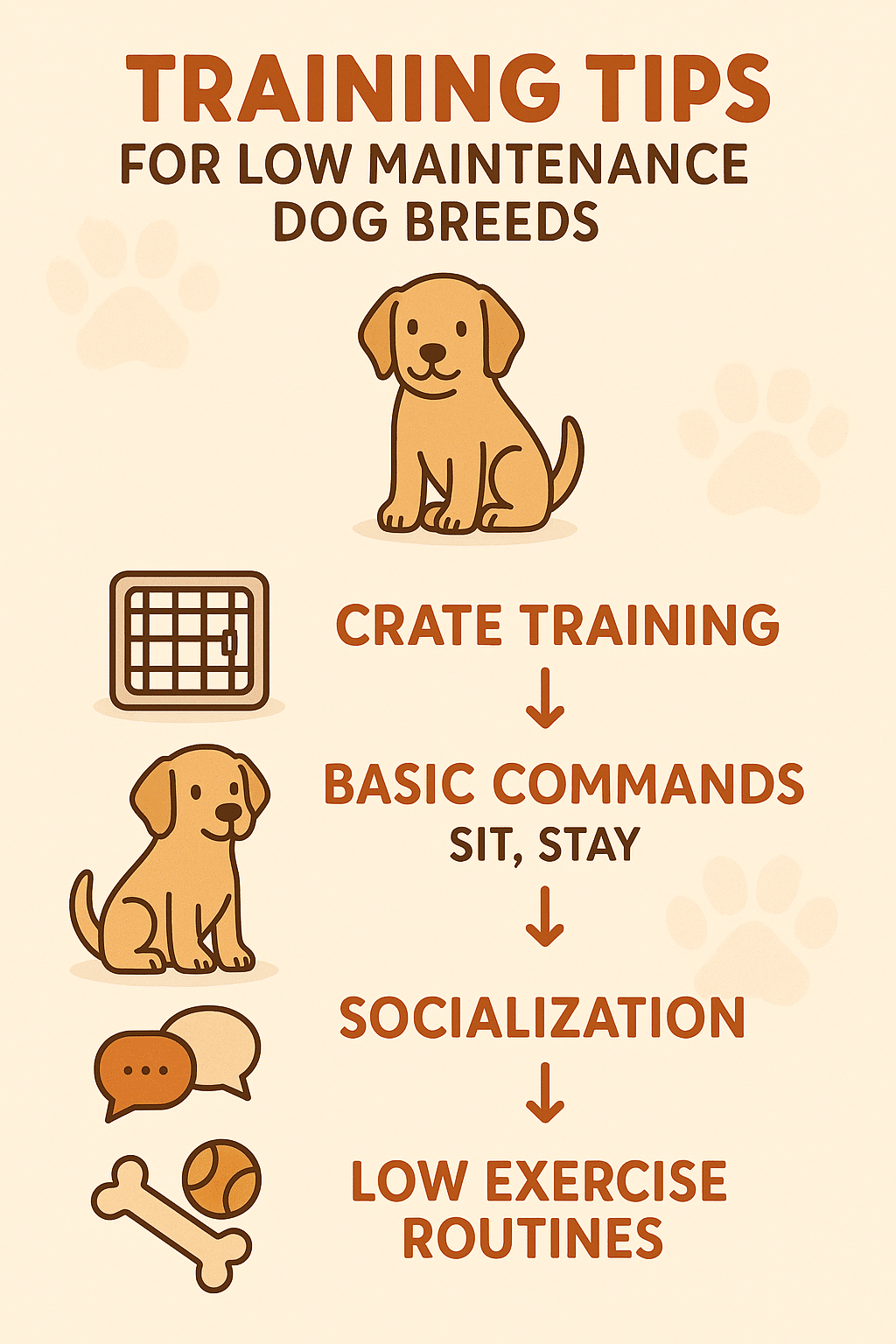
To ensure you select a dog that genuinely fits your family’s lifestyle, let’s review the essential criteria.
Living Space Compatibility: Apartment-Friendly vs. Large Home Needs
Space matters. Busy families often live in apartments or homes with limited yard space. A low maintenance dog breed for apartment living should naturally thrive in smaller quarters without demanding constant outdoor time. Dogs with low to moderate energy levels that adapt well to indoor environments are ideal.
Conversely, larger breeds generally require more space and may struggle in tight living conditions unless they get ample daily exercise. For apartment dwellers, breeds like the French Bulldog or Cavalier King Charles Spaniel excel. Families in larger homes can consider calm large breeds that are still low maintenance, like the Great Dane.
Size Categories: Small, Medium, and Large Breeds with Low Demands
Size dramatically impacts care demands. Small low maintenance dog breeds for first-time owners often have lower food consumption, require less grooming, and are easier to manage physically.
Medium-sized dogs with low exercise needs balance robustness with temperament suited to family life. Large breeds may surprise you; some, like the Mastiff, despite their size, boast a calm demeanor and limited exercise requirements.
Understanding these size-related nuances helps tailor your choice.
Family and Senior-Friendliness: Temperament and Behavior Traits
When choosing low maintenance dog breeds for children or seniors, temperament is key. You want dogs that are patient, gentle, and tolerant of varying energy levels and routines. Certain breeds have innate friendliness and adapt well to children’s playful chaos or seniors’ quieter pace.
Low maintenance dog breeds suitable for seniors typically are calm, easy to groom, and don’t require intense physical activity.
Hypoallergenic and Low Shedding Options for Allergy Sensitivity
As I mentioned earlier, hypoallergenic dogs can be a lifesaver for families with allergic members. While no dog is entirely allergen-free, breeds such as the Maltese, Poodle mixes, or Soft Coated Wheaten Terriers offer lower dander levels and shed minimally.
Selecting hypoallergenic, low maintenance dog breeds ensures everyone in your household enjoys the companionship without discomfort.
Comprehensive Profiles of the 5 Best Low Maintenance Dog Breeds for Busy Families
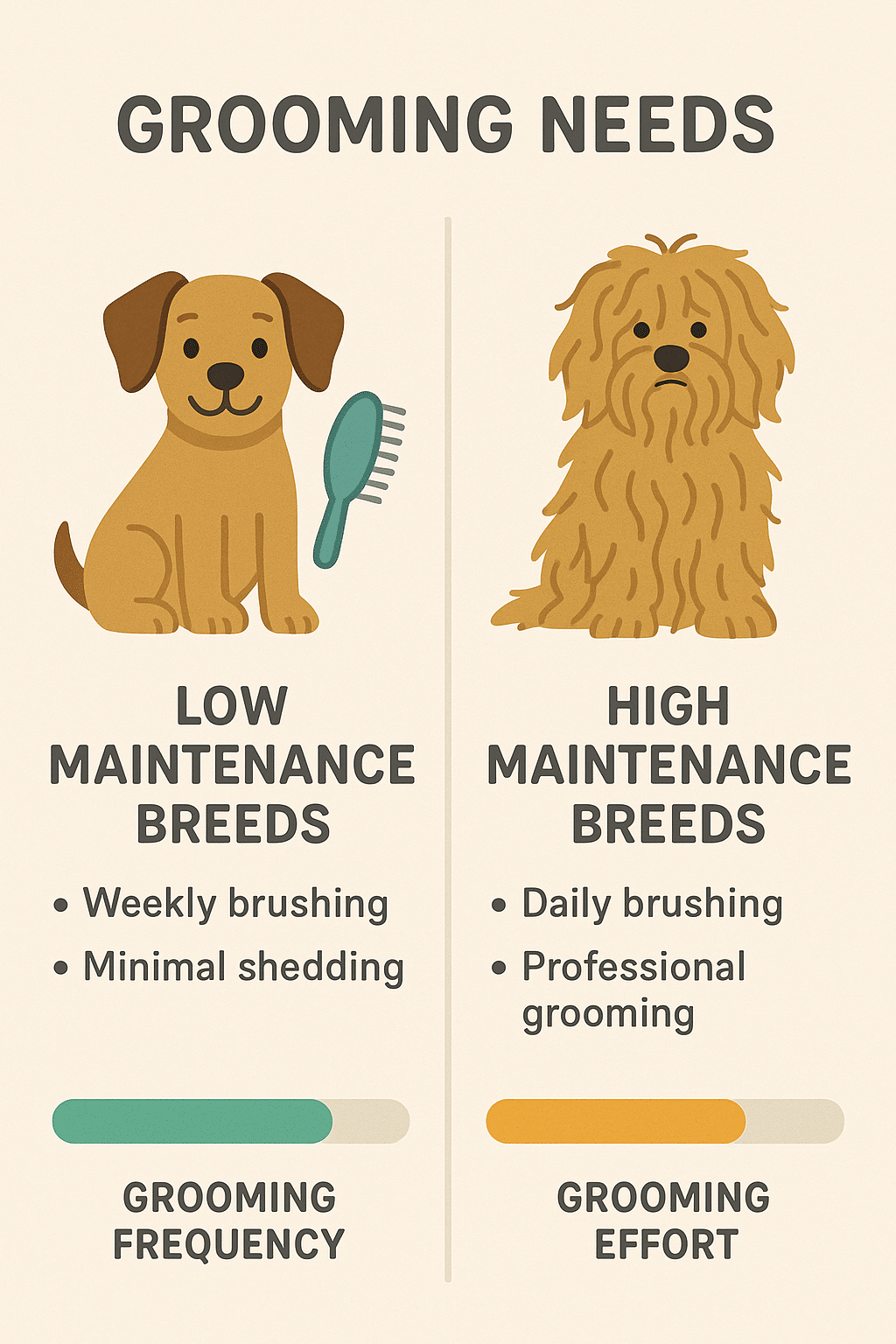
Let’s get to the heart of this article—the top five breeds expertly selected for their balance of ease, temperament, and suitability for busy families.
1. French Bulldog
Overview: French Bulldogs have skyrocketed in popularity because of their adorable look and manageable personality. Compact and muscular, they’re perfectly sized for small living spaces.
Grooming: Their short coat sheds lightly and requires minimal grooming—just weekly brushing and occasional baths.
Shedding: Low shedding breed, good for allergy-sensitive homes.
Exercise Needs: Moderate: short walks and indoor play suffice. They tire easily, which suits families with limited time.
Temperament: Playful, affectionate, and easygoing. Frenchies are great with kids and seniors thanks to their gentle natures. They rarely bark excessively, contributing to peaceful living.
2. Bichon Frise
Overview: The Bichon Frise is a cheerful, small dog with a curly, poodle-like coat.
Grooming: While they need regular grooming every 4-6 weeks professionally, daily brushing prevents matting. Despite grooming frequency, their overall maintenance remains low due to temperament and indoor suitability.
Shedding: Considered hypoallergenic with very low shedding.
Exercise Needs: Low to moderate; daily short walks and play suffice.
Temperament: Highly social, great with children, seniors, and other pets. They thrive on companionship but can adjust well if you’re busy.
3. Basenji
Overview: Known as the “barkless dog,” the Basenji hails from Africa and is notable for its quiet demeanor.
Grooming: Their smooth, short fur is easy to maintain with weekly brushing.
Shedding: Minimal shedding and low dander, making them suitable for allergy sufferers.
Exercise Needs: Moderate; they’re active but don’t require endless running.
Temperament: Intelligent, independent, and clean. Basenjis are good for families who want a quieter, less demanding dog that’s still affectionate.
4. Cavalier King Charles Spaniel
Overview: This small to medium breed shines as a loving, gentle family dog.
Grooming: Their silky coat requires weekly brushing but isn’t typically high maintenance.
Shedding: Moderate shedding, so regular vacuuming and grooming help manage dander.
Exercise Needs: Moderate; they enjoy walks and play but also rest contentedly indoors.
Temperament: Extremely friendly, patient with children, and adaptable to seniors.
5. Shih Tzu
Overview: Shih Tzus are charming little dogs bred as companions.
Grooming: Annual trimming and weekly brushing keep their long hair manageable. They’re low maintenance with proper grooming techinques.
Shedding: Very low, hypoallergenic breed.
Exercise Needs: Low; short walks and indoor play meet their needs.
Temperament: Affectionate, social, and calm — perfect for busy families who want cuddly company with minimal hassle.
Puppy Training Tips for Low Maintenance Dog Breeds
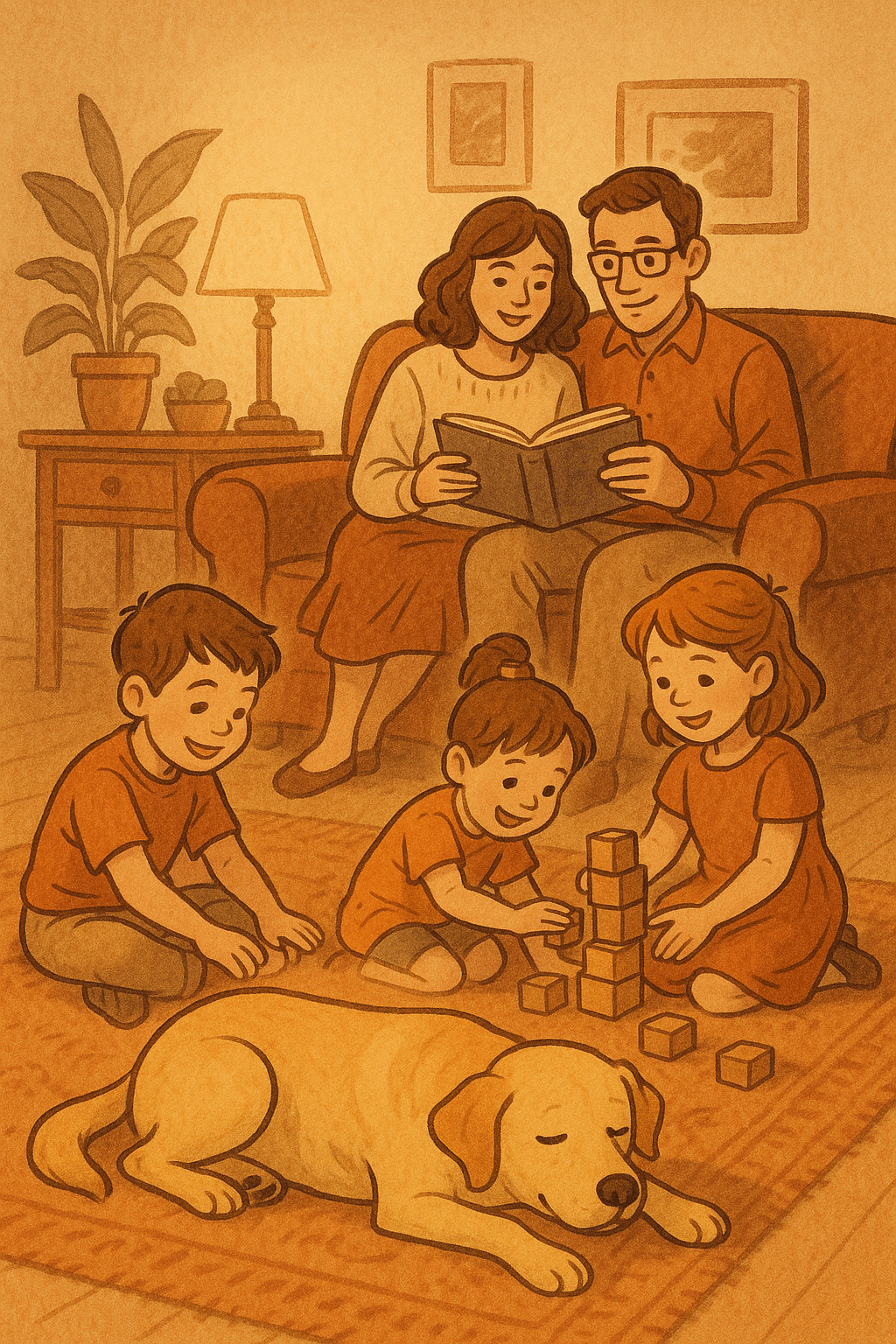
Training a puppy can sound intimidating, but with the right strategies tailored to low maintenance breeds, you’ll set yourself up for success.
Easy-to-Train Traits and Behavioral Instincts
Low maintenance breeds typically possess intelligence and a willingness to please, which shortens training time. Positive reinforcement methods, like treats and verbal praise, are highly effective.
Consistency is key—daily short sessions (10-15 minutes) work best. Many of these breeds respond well to crate training and early socialization, which eases separation anxiety.
Managing Exercise Requirements Without Overexertion
For breeds with moderate activity needs, balance is crucial. Over-exercising young puppies may cause injury, so stick to gentle walks and indoor play.
Use puzzle toys or treat-dispensing feeders to add mental stimulation—this curbs boredom without exhausting energy reserves.
Techniques to Encourage Calm Indoor Behavior
Teaching “settle” and “quiet” commands early helps prevent nuisance barking and destructive behaviors. Providing a cozy, designated resting spot encourages calmness.
Reward calm behavior lavishly, and provide chew toys to channel energy positively.
Grooming Essentials for Low Maintenance Dog Breeds
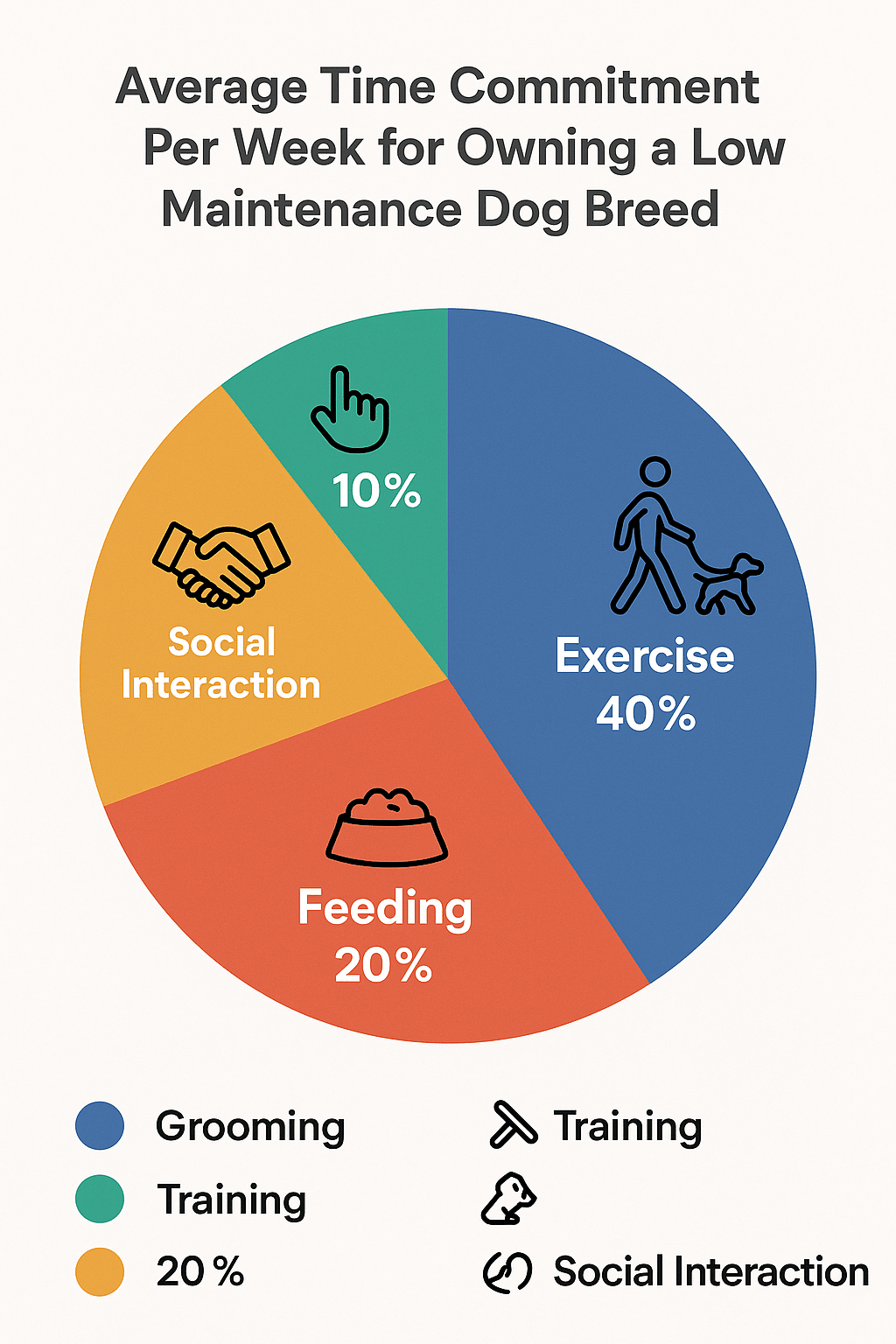
Keeping grooming quick yet effective is the hallmark of caring for these breeds.
Tools for Quick and Efficient Grooming
Essential grooming tools include:
- Slicker brush or pin brush (depending on coat type)
- Nail clippers or grinders
- Dog-friendly shampoo (gentle formulation)
- Ear cleaner (for breeds prone to infections)
Setting up a weekly grooming routine with these tools prevents buildup.
Maintaining Healthy Skin and Coat with Minimal Effort
Bathing once every 4-6 weeks is usually sufficient, except when the dog gets dirty. Regular brushing distributes natural oils and reduces shedding.
Watch for skin irritations or dryness and consult a vet promptly to avoid escalating issues.
Scheduling Regular but Infrequent Care to Reduce Time Investment
Professional grooming, particularly for breeds like Bichon Frise and Shih Tzu, is best every 6-8 weeks. Booking appointments in advance saves you last-minute stress.
Exercise and Wellness Strategies for Busy Families
Busy families can manage their dog’s health without dedicating excessive time by following smart exercise and wellness plans.
Low Energy Dog Breeds: Balancing Activity and Rest
Most low maintenance dog breeds enjoy a healthy balance between short bursts of play and quiet rest periods. Avoid daily over-exercising — this can lead to joint problems or behavioral issues.
Scheduling regular but concise walks combined with indoor interactive time works wonders.
Indoor Activities and Enrichment for Limited Outdoor Time
Interactive treat puzzles, chew toys, obedience training games, and scent-based activities keep your dog engaged without needing long outdoor sessions.
Rotating toys prevents boredom and maintains excitement.
Health Monitoring Tailored to Low Maintenance Breeds
Regular vet checkups, dental care, and vaccinations remain critical. Observing changes in appetite, coat condition, or energy levels helps catch early signs of health concerns.
Addressing Common Challenges: Barking, Allergies, and Separation Anxiety
Even low maintenance breeds face some hurdles. Here’s how to manage common issues.
Selecting Breeds That Bark Less for Peaceful Living
If noise is a concern, look for breeds like Basenji and French Bulldog that naturally bark less. Training can also help reduce excessive barking by teaching the “quiet” command.
Managing Dander and Allergens Effectively
Frequent vacuuming, using HEPA air purifiers, and washing dog bedding weekly improve air quality. Grooming removes loose hair and dander, keeping allergen levels down.
Ensuring Emotional Stability in Busy Household Environments
Providing consistent routines, quality attention when possible, and safe spaces prevents separation anxiety. Crate training and obedience commands also support emotional health.
Unique Perspectives: Integrating Low Maintenance Breeds Into High-Activity Family Lifestyles
Even if your family leads a high-energy lifestyle, these breeds can adapt beautifully.
Leveraging Dog Temperament to Complement Busy Schedules
Breeds with calm natures often adapt to your pace, appreciating quiet moments after active days. Understanding their limits prevents stress for both dog and family.
Combining Breed Characteristics With Modern Pet Care Technologies
Tech like automatic feeders, pet cameras, and interactive toys keeps your dog engaged and cared for during busy periods. This fusion boosts care while fitting your modern lifestyle.
Long Lifespan Considerations to Build Long-Term Companionship
Some low maintenance breeds live well into their teens, creating lasting bonds. Planning for lifelong responsibility includes budget, health investment, and emotional readiness.
Final Checklist: How to Choose and Care for Your Low Maintenance Dog Breed
Here’s a quick reference before you make that all-important decision.
Matching Lifestyle Needs and Breed Characteristics
- Evaluate your daily time available for walks, grooming, and training.
- Consider living space and family members’ allergy status.
- Select breeds that align with activity level and temperament preferences.
Essential Supplies and Preparations for New Dog Owners
- Quality leash, collar, and harness
- Food and water bowls
- Crate or bed
- Grooming tools tailored to your breed
- Age-appropriate toys and training aids
Building a Support Network: Vet Care, Professional Groomers, and Training Resources
- Establish a relationship with a trusted local veterinarian.
- Schedule regular grooming appointments if needed.
- Consider obedience classes or professional training for behavioral support.
FAQs about Low Maintenance Dog Breeds
Q1: What are the best low maintenance dog breeds for busy families?
A1: Breeds like the French Bulldog, Bichon Frise, Basenji, Cavalier King Charles Spaniel, and Shih Tzu top the list due to their easy grooming, manageable exercise needs, and calm temperaments.
Q2: Are low maintenance dog breeds suitable for apartment living?
A2: Absolutely. Many low maintenance breeds, such as the French Bulldog and Bichon Frise, thrive in apartment settings because of their small size and moderate exercise requirements.
Q3: Which low maintenance dog breeds shed the least?
A3: Basenjis, Bichon Frises, and Shih Tzus are known for low shedding coats, making them better choices for allergy sufferers and busy owners who want less cleaning.
Q4: Can low maintenance dog breeds be good for seniors?
A4: Yes, breeds with calm temperaments and low exercise needs, like the Cavalier King Charles Spaniel and French Bulldog, are excellent companions for seniors.
Q5: What are effective puppy training tips for low maintenance dog breeds?
A5: Focus on positive reinforcement, short consistent training sessions, early socialization, and teaching commands like “quiet” and “settle” to encourage calm indoor behavior.
Quick Takeaways/Key Points
- Low maintenance dog breeds balance minimal grooming, moderate exercise, and calm temperament.
- Space and family composition heavily influence the best breed for your household.
- French Bulldog, Bichon Frise, Basenji, Cavalier King Charles Spaniel, and Shih Tzu offer excellent low maintenance qualities.
- Proper puppy training and consistent grooming keep your dog’s needs manageable.
- Utilizing pet care technology can help integrate a dog smoothly into busy schedules.
- Watching for health changes and managing allergies preserves family-wide well-being.
- A thorough preparation and support network ensure long-term success with your new pet.
Conclusion
Selecting one of the best low maintenance dog breeds for busy families can transform your experience, bringing joy without overwhelming your daily routine. By understanding grooming demands, temperament traits, and exercise needs, you position yourself to make a thoughtful, informed choice that benefits all household members. Remember, the right dog is more than a pet—they’re a lifelong companion who matches your lifestyle and heart.
Now that you’ve got all this knowledge in your back pocket, I encourage you to reflect on your lifestyle, preferences, and home environment. Take the plunge with confidence, and prepare for the wonderful journey of dog ownership that fits right into your busy life. Your perfect low maintenance companion awaits!
For further reading on these breeds and expert care advice, consult resources like the American Kennel Club, or your local veterinarian.


